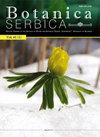Boron toxicity tolerance in barley may be related to intrinsically higher levels of reactive oxygen species in the shoots
IF 1.1
4区 生物学
Q4 PLANT SCIENCES
引用次数: 0
Abstract
There is considerable intra-and interspecific variation in boron (B) toxicity tolerance in crop plants. In this study, we aimed to investigate the mechanisms involved in tolerance to excess B in barley (Hordeum vulgare) in the early stages of plant development. To do this, B-sensitive (B?lb?l-89) and B-tolerant (Tarm-92) barley cultivars were grown hydroponically under control and B stress conditions (10 mM H3BO3) for 4 or 7 days. The hydrogen peroxide (H2O2), malondialdehyde (MDA), total phenolic, total flavonoid, anthocyanin, proline, and total sugar contents, as well as DPPH radical scavenging capacity, were then determined for both cultivars. Our results showed that B treatment led to significant increases in the B concentration of the barley cultivars for both exposure times. However, there were no drastic differences in the B concentration of the roots and shoots between the sensitive and tolerant cultivars. While the dry root weight of B?lb?l-89 was reduced after 7 days of B stress (p < 0.05), such a decrease was not observed in Tarm-92. The H2O2, MDA, proline, total sugar, and anthocyanin contents of both cultivars increased considerably in response to excess B during at least one treatment period (p < 0.05). The H2O2 content of Tarm-92 under control and B stress conditions was significantly greater than that of B?lb?l-89, but there was no difference in the MDA content and radical scavenging capacity between the two cultivars. Finally, a 35% increase was found in the total flavonoid content of the Tarm-92 seedlings exposed to B stress for 4 days. In conclusion, the findings of this study suggest that tolerance to B toxicity in barley seedlings may be related to their capacity to tolerate higher levels of reactive oxygen species.大麦对硼的耐受性可能与芽部活性氧含量较高有关
作物对硼(B)毒性的耐受性存在相当大的种内和种间差异。在这项研究中,我们旨在研究大麦(Hordeum vulgare)在植物发育早期对过量B的耐受机制。为此,在对照和B胁迫(10 mM H3BO3)条件下水培B敏感(blb -89)和B耐(Tarm-92)大麦品种4天或7天。测定了两个品种的过氧化氢(H2O2)、丙二醛(MDA)、总酚、总黄酮、花青素、脯氨酸和总糖含量,以及清除DPPH自由基的能力。结果表明,在两种暴露时间下,B处理均显著提高了大麦品种的B浓度。而根和芽中B的浓度在敏感品种和耐受品种之间没有显著差异。而干根重B?lb?B胁迫7 d后,l-89降低(p < 0.05),而在Tarm-92中未见明显降低。在至少一个处理期内,两个品种的H2O2、MDA、脯氨酸、总糖和花青素含量均显著增加(p < 0.05)。对照和B胁迫条件下Tarm-92的H2O2含量显著高于B?l-89,但MDA含量和自由基清除能力在两个品种间无显著差异。结果表明,B胁迫处理4 d后,Tarm-92幼苗总黄酮含量增加了35%。总之,本研究结果表明,大麦幼苗对B毒性的耐受性可能与其耐受较高水平活性氧的能力有关。
本文章由计算机程序翻译,如有差异,请以英文原文为准。
求助全文
约1分钟内获得全文
求助全文
来源期刊

Botanica Serbica
Agricultural and Biological Sciences-Plant Science
CiteScore
1.40
自引率
12.50%
发文量
17
审稿时长
34 weeks
期刊介绍:
Botanica Serbica publishes original research papers on all aspects of plant, fungal and microbial biology research including the disciplines of microbiology, mycology, lichenology, bryology, flora, vegetation, biogeography, systematics, taxonomy, plant biotechnology, plant cell biology, plant ecology, environmental plant biology, forestry, genomics, horticulture, limnology, metabolomics, molecular biology, proteomics, virology, plant conservation and protection, and wildlife and ecosystem management.
 求助内容:
求助内容: 应助结果提醒方式:
应助结果提醒方式:


